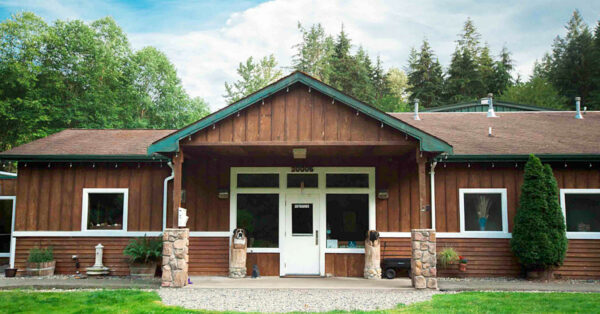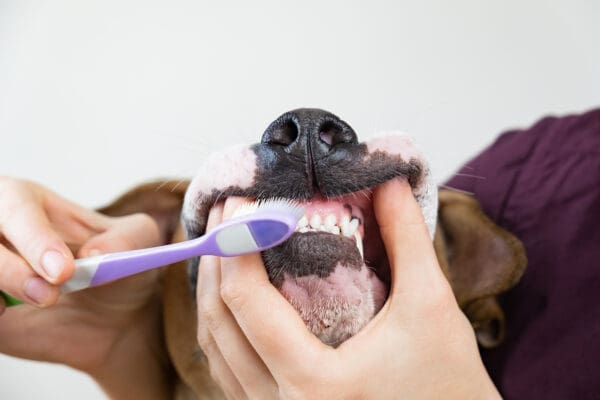
11401 NE 195th St. Bothell, WA 98011
(425) 486-9000 PHONE (425) 486-9002 fax
Natural History
The genus Tiliqua contains over 10 recognized species and subspecies of blue-tongued skinks which all have fairly similar care requirements. These animals get their common name from the bright blue tongues that they display when startled and during territorial disputes. As pets, they rank high on the list of desired pets for budding reptile owners because of their calm, friendly dispositions.
Blue-tongue skinks are found in the wild throughout much of New Guinea and Australia, in a wide variety of habitats. Animals hailing from Australia’s interior deserts are adapted to a harsh desert lifestyle, while those species from more northern ranges are used to a more tropical environment. Depending on the sub-species, blue-tongues can reach lengths of up to 27 inches. With proper care, these lizards can live for 20 years or more.
Husbandry
Housing: Baby blue-tongues should be housed singly in plastic reptile enclosures, terrariums, or 20-gallon aquariums with full screen tops. An adult blue-tongued skink requires, at minimum, a 40-55 gallon aquarium or an enclosure measuring 36”W x 18”D x 10”H with a full screen top. Blue-tongued skinks are terrestrial, and prefer floor space over climbing area. They are best kept singly. Newspaper, paper towels, and reptile carpet are recommended as substrates, as they are inexpensive and easy to clean. Reptile bark, sphagnum moss, and non-aromatic mulch are moderately absorbent, and provide burrowing material; however, these products trap moisture, and must be changed frequently to prevent bacterial or fungal growth. Avoid sand, gravel, corncob, pine, or cedar/pine shaving bedding, as they may cause gastrointestinal blockage and/or contribute to respiratory infections.
Heating: Reptiles control their body temperature through thermoregulation, so it is crucial for the skink’s enclosure to have a warm side and a cool side. The ambient temperatures on the enclosure should range from 75-85F, with a basking area of 90-105F during the daylight hours. Temperatures should not drop below 70F at night. Appropriate heating elements are ceramic heat emitters or various heat bulbs (provided that any light-emitting heat bulbs are turned off at night), or under tank heaters attached to thermostats. It is important to purchase a temperature gun, or digital thermometers that possess probes, for accurate temperature readings. Plastic dial thermometers, or any thermometer with a fixed placement, are often unreliable, and do not adequately gauge thermal gradients inside entire enclosures.
Lighting: UV lighting is necessary for the health of all blue tongues, and it comes in two equally necessary forms. UVA rays are radiation waves that are needed to promote natural behaviors and stimulate appetite. UVB rays are the other type of radiation waves, necessary for the metabolism of calcium and bone health. A good way to tell the two UV rays apart is “A for appetite, B for bones.” UVB is only provided in 2 different kinds of lights: florescent lights specifically designed for UVB output in reptiles, and mercury vapor bulbs. Some bulbs sold in pet stores are labeled as being “full spectrum,” and packaging may erroneously lead you to believe that a bulb that produces UVA only is enough for a blue tongue, but unless the box specifically states that it offers UVB lighting, it will not be what your pet needs. All UVB bulbs will provide UVA, but not all UVA bulbs will provide UVB. Florescent bulbs for reptiles come in a few different styles, the most common being the coil variety, and the tubular strip variety. Coil fluorescents have the shortest lifespan of all UVB bulbs, and even though they may continue to produce visible light for years, the UVB they provide will only last about 3-4 months. Strip fluorescents are similar, but can last 4-6 months. Mercury vapor bulbs are among the longest lasting UVB sources on the market (with the potential to produce UVB for up to a year); these bulbs also produce heat. All bulbs should be replaced every 4-6 months, unless their output is being routinely measured with a UVB meter to ensure that they are producing adequate spectrum of lighting. It is important to allow the your skink to get within 12 inches of any UVB light source you do provide, as the distance of the light can greatly affect the amount of UVB absorbed. Regardless of what artificial light you provide, nothing beats the power of the sun. Supervised outdoor time during warm, summer days will benefit your skink tremendously.
Humidity: Clean water should always be accessible in an appropriate water dish large enough for the skink to climb into for soaking. Blue-tongued skinks are not good swimmers, and must be able to easily enter/exit the water bowl. Humidity levels ranging between 25% and 45% are ideal for most blue-tongued skinks, and can be achieved by misting the enclosure daily or providing a humid hide. Placing the water dish under an overhead heat source will promote evaporation and increase ambient humidity. The water bowel should be cleaned daily, as skinks will often defecate in their water source.
Diet
Blue-tongues are omnivorous, and should be fed a combination of proteins, vegetables, and fruits. Variety is important for nutritional diversity. Young blue-tongues do best when fed daily or every other day, while adult skinks should be fed every two to three days. Feed them as much as they will eat in one sitting. After your skink has stopped eating, uneaten food should be removed immediately. As juveniles, half of the skink’s diet comes from insects, whereas adults will eat proportionately more plant matter. A dietary ratio of 60 percent plant material and 40 percent animal protein is ideal for adults. Fruit should comprise about 10% of the plant material portion, with the remainder being leafy greens and mixed vegetables.
Examples of healthy plant material options include collard greens, mustard greens, turnip greens, dandelion greens, watercress, bok choy, escarole, Swiss chard, parsley, kale, spinach, romaine, carrot and beet tops, frozen/thawed mixed vegetables, squash, zucchini, sweet potato, bell pepper, broccoli, okra, carrot, pumpkin, snap peas, snow peas, and green beans. Avoid pale greens such as iceberg lettuce or celery tops. Vary the vegetables used, and use spinach sparingly as it can bind up calcium within the body. Healthy fruit options include bananas, berries, grapes, papayas, melons, kiwis, apples, mangos, oranges, peaches, and pears.
Examples of healthy animal protein sources include: roaches, crickets, superworms, mealworms, waxworms, hornworms, nightcrawlers, hard boiled eggs, tilapia, salmon, cooked and ground beef/turkey/chicken, canned high quality dog food (such as Wellness, Blue Buffalo, Merrick, etc), and occasional pinkie mice. Vary the items used. If feeding canned dog/cat foods to your blue-tongued skink, be sure to feed only high-quality foods and feed them sparingly (<10% of the total diet). Avoid corn-based foods, as well as foods that contain artificial colors. Many foods are available with fruits and vegetables included, and while they are no substitute for fresh produce, they are preferred over 100%-protein cat/dog foods. Cat foods usually contain twice the protein of dog foods, and are only recommended for use with emaciated or reproductively active skinks.
Supplementation: Blue tongued skinks require additional calcium supplementation. Calcium powder is manufactured by many different brands on the market (Fluker’s, Exo-Terra, Rep-Cal, etc; whatever brand you choose, select a product that does not contain phosphorous or vitamin D3. It should be sprinkled onto the food 4-5 times weekly for skinks less than 1 year old, and 2-3 times weekly for adults. Vitamins are also important to promote healthy body function. There are many brands that make multivitamins appropriate for reptiles (Herptivite, Reptivite, Vionate, etc). Vitamins (especially fat soluble vitamins such as A and D) are easy to overdose, and too much vitamin supplementation can actually be harmful. As a general rule, a reptile multivitamin supplement should be sprinkled on the food once weekly for blue tongued skinks less than 1 year old, and twice monthly for adults.
Handling
Blue-tongued skinks are docile, curious lizards. They tame quickly, and are usually easily handled. Like many lizards, some blue-tongues may confuse human fingers with food if they are hungry and the fingers smell like food items. To prevent this, it is best to wash your hands before handling any skink. It is also very important to wash your hands AFTER handling the skink to reduce the risk of contracting Salmonella bacteria.
Common Medical Issues
Mouth Rot: This can be caused by improper humidity levels, bacterial infections, or incessant rubbing of the face on enclosure walls. All open wounds should be seen by a reptile veterinarian to prevent worsening infection from occurring.
Parasites: Internal parasites in the gastrointestinal tract can be present in any lizard and can exacerbate an already ill animal’s problems. The best way to prevent this from being an issue is to have yearly fecal exams with your veterinarian while maintaining excellent husbandry at home. Skinks can get these parasites from their food, their environment, and from each other. External parasites, such as mites and ticks, need to be treated immediately, as they can be vectors for fatal viral diseases.
Respiratory: Excessive dryness, cool temperatures, or even continued exposure to a dirty environment can all lead to the infection of a skink’s respiratory system. If you notice that your skink is breathing with its mouth open, making noises during breathing, or exhibiting discharge or bubbles from its nostrils or mouth, contact a reptile veterinarian immediately.
Metabolic Bone Disease: Also known as MBD, this is a term used to describe a number of disorders related to the weakening of bones or impaired system function caused by an imbalance of calcium, phosphorus, or vitamin D3. It is one of the most commonly seen health problems in lizards, and is often the result of inadequate levels of calcium in the diet, or improper UVB lighting which is essential for calcium absorption. Symptoms of MBD range from the mild (lethargy, lack of appetite) to the severe (rubbery bones, spinal deformities, tremors and twitching of the extremities). Veterinary care is a must for any blue-tongued skink with suspected MBD.
March 30, 2015
Content of this Care Sheet Courtesy of:
The Center for Bird and Exotic Animal Medicine
11401 NE 195th St. Bothell, WA 98011
(425) 486-9000 PHONE (425) 486-9002 fax



